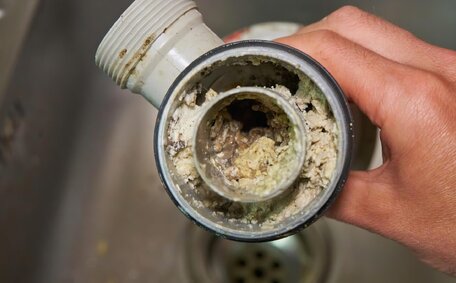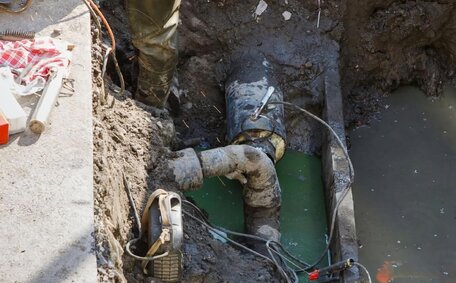How Pipe Relining Works
Pipe relining is a trenchless pipe repair method that involves inserting a new pipe inside the damaged pipe to restore functionality and flow. Pipe relining is a trenchless pipe repair method that involves inserting a new pipe inside the damaged pipe to restore functionality and flow.
Once the damage is pinpointed, they use high-pressure water jets to clean out the existing pipe and prepare it for relining.
A strong, flexible epoxy resin liner reinforced with fibreglass is fed through the pipe. The end result is a restored pipe with improved flow capacity that lasts for decades. As the epoxy resin hardens, it forms a smooth, uniform and leak-proof surface inside the damaged pipe.
This liner is expandable to fit snugly against the walls of the old pipe and bonds with it as the resin cures.
Relining avoids the need to dig trenches or break up floors and walls to access and replace pipes. It takes just a day or two to complete with minimal disruption to homes and businesses.
The process reinforces old pipes from the inside, eliminating leaks, clogs and corrosion damage. Overall, pipe relining is an eco-friendly and long-lasting solution for restoring pipes.
Benefits of Pipe Relining
There are many advantages to choosing pipe relining over traditional pipe replacement:
Minimal property damage: Because pipe relining is a trenchless method, it requires no digging or destruction to floors, walls, landscaping, etc. This results in less mess and lower repair costs.
Improved flow: The smooth, uniform epoxy coating enhances water flow and pressure. There are no joints or seams that can trap debris.
Increased durability: The epoxy liner is extremely durable and can extend the lifespan of pipes by decades. It stands up to corrosion and handles temperature fluctuations well.
Faster installation: Pipe relining takes 1-2 days compared with the weeks needed to dig trenches and replace pipes.
Reduced environmental impact: With no excavation required, pipe relining is an eco-friendly solution that preserves trees and vegetation.
Overall, pipe relining boosts plumbing system efficiency at a fraction of the cost of full replacement. It’s a smart, long-lasting pipe repair method for both homes and businesses.
Cost Savings
Pipe relining offers significant cost savings compared to full pipe replacement in several ways:
Lower labour costs: Because no excavation is required, labour costs for relining projects are 50-70% less than replacement projects that require extensive digging and demolition.
Minimal property damage: Avoiding the need to dig trenches or break up walls/floors means very little restoration work is needed after relining. This provides major cost savings.
Faster installation: Relining takes 1-2 days versus weeks for full replacement. Less downtime equals lower labour costs.
No landscaping expenses: Since relining is trenchless, there is no need to remove trees, plants or hardscaping. Replacing these elements is very costly.
Longer lifespan: The epoxy liner lasts 50+ years. Replacement pipes may need repairs sooner, requiring added expenditures down the road.
For both residential and commercial buildings, pipe relining provides excellent value. The minimal invasiveness and longevity of this trenchless method adds up to big cost savings in plumbing repairs.
Minimal Property Damage
One of the biggest benefits of pipe relining is that it causes minimal damage to property compared to full pipe replacement. Because no digging or trenching is required, existing floors, walls, and landscaping are left undisturbed.
With traditional pipe repair methods, yards may need to be dug up, concrete or asphalt driveways broken up, and sections of walls or floors ripped out to access and replace pipes.
This destruction is expensive to repair. Lawns, garden beds, trees, and hardscaping elements like pathways or retaining walls often must be replaced after. The mess, expense, and hassle is substantial.
Pipe relining avoids all this collateral damage. There is no need to demolish or rebuild after relining.
The flexible resin liner is inserted through a small access point, leaving the surroundings untouched. At most, a few tiny holes may be drilled to pump in the epoxy, causing little noticeable effect.
By keeping destruction to a minimum, pipe relining reduces repair costs significantly. Homeowners and businesses save money, time, and disruption. The non-invasive nature of the process is a major plus for anyone needing plumbing repairs.
Increased Flow Rates
One of the biggest perks of pipe relining is it can significantly increase water flow rates and water pressure compared to old, damaged pipes. There are a few reasons this occurs:
Smoother interior: The seamless, epoxy resin liner creates a uniform surface without any protrusions, gaps, or corrosion where debris can build up and impede flow.
Increased capacity: If the original pipe was narrowed due to corrosion, buildup, or roots, relining restores the full diameter. This allows more water to flow through.
Fewer leaks: Leaks force water to escape the pipe, decreasing pressure. The leak-proof relined pipe keeps all water inside, boosting flow.
Friction reduction: The smooth epoxy eliminates friction and turbulence, allowing water to glide efficiently through the pipe.
Improved flow means fixtures get more water pressure. Showers, faucets, sprinklers and appliances fill faster. In all, pipe relining optimises the plumbing system’s performance.
Reduced Leaks and Water Waste
One of the most impactful benefits of pipe relining is it greatly reduces leaks and water waste. Leaking pipes lose an estimated 20% of transported water through cracks and corrosion damage. This squandered water ultimately costs homeowners or businesses more in utility bills.
The smooth, uniform epoxy liner seals up leaks along the full length of relined pipes. This prevents clean drinking water from haemorrhaging out and being lost underground. Pipe relining can therefore lead to substantial cost savings on water bills once leaks are eliminated.
On a wider scale, reducing leaks through proactive relining also conserves water overall. With populations rising and droughts becoming more common, protecting our water resources is crucial. Pipe relining plays an important role by plugging leaks that contribute to unnecessary wastage everyday.
For the sake of our pipes, wallets and environment, pipe relining provides a lasting solution to leakage issues. The technology is proven to minimise water loss over decades of use compared to pipe materials that corrode and fail over time.
Pipe Materials Suitable for Relining
The most suitable pipe materials for relining include:
- PVC (polyvinyl chloride)
- Concrete
- Cast iron
- Galvanised steel
- Copper
- ABS (acrylonitrile butadiene styrene)
- PEX (cross-linked polyethylene)
PVC, cast iron, galvanised steel, and copper pipes are very commonly relined, as they were extensively used in construction over the past century. Concrete pipes also often need repairs.
PVC is relatively easy to reline and provides the best bonding with epoxy resin. Concrete, cast iron, and steel pipes may need preparatory work like corrosion removal but also achieve excellent adhesion. Copper requires some abrasion first to help the liner adhere properly.
In general, pipes that are uniform in diameter throughout, relatively straight, and accessible work best for relining. Materials that resist corrosion are also preferred. Rigid pipes hold up better over time than flexible ones which can sag.
Relining can restore most piping to like-new condition at a fraction of replacement cost. Speak to a professional plumber to determine if your pipes are suitable candidates for this trenchless repair method.
The Pipe Relining Process
Here are the key steps involved in relining a pipe:
- Inspection - A camera is fed through the pipe to pinpoint any damage like cracks, blockages or root intrusion. This allows the plumber to see the interior condition of the pipe.
- Cleaning - High pressure water jets are used to scour the inside of the pipe and remove any built-up deposits or debris.
- Resin wetting - The pipe is filled with water, and the lining is thoroughly saturated with epoxy resin. This prepares it for insertion and expansion.
- Lining insertion - The wetted liner is fed through the pipe and gradually inflated with air pressure until it presses tightly against the pipe walls.
- Curing - The epoxy resin is allowed to cure, hardening the liner and bonding it permanently to the old pipe. This usually takes a few hours.
- End connections - The ends of the liner are trimmed flush and reconnected to pipes, valves, etc. with sealants and couplings.
- Inspection - A final camera inspection checks the liners placement and verifies leaks have been sealed.
And that’s it! In just a day or two, the pipe relining process is complete, restoring functionality for decades. It’s a fast, effective and minimally invasive repair method.
Inspection and Measurement
The first critical step in any pipe relining project is a thorough inspection and measurement of the damaged pipe. A specialised camera is fed through the pipe, providing a full visual assessment of the interior condition.
The camera inspection identifies problem areas like cracks, leaks, blockages or collapsed sections. It also accurately measures the length and diameter of the pipe to ensure the new liner is sized correctly. Factors like bends, joints and any reductions are noted.
Precise measurements are crucial so the flexible liner can be cut to the right length and properly expand to seal leaks and reconnect fittings. The inspection footage also helps the plumber determine what sections may need repairs or debris removal before relining.
Armed with this visual data, the plumber can craft a relining solution tailored to the pipe’s unique damage and dimensions. The information guides each subsequent step of the process for optimal results. Thorough inspection and measurement sets the stage for effective, long-lasting pipe relining.
Cleaning the Pipes
Before pipe relining can occur, the existing pipes need to be thoroughly cleaned. This is a crucial step, as any debris, buildup or obstructions present could impede proper installation of the epoxy liner.
High-pressure water jets are typically used to clean out old pipes in preparation for relining. The powerful spray scours the interior pipe walls and forces out years of accumulated mineral deposits, rust particles, roots, and grime.
Cleaning opens up the full diameter of the pipe so the flexible liner can adhere evenly. It also allows the plumber to inspect for any damage that may need repairing first. Sections with cracks or holes can be patched prior to relining.
Some pipes may also undergo abrasion or descaling with mechanical tools as part of the cleaning process. This further etches the surface for enhanced epoxy bonding.
A clean, debris-free pipe interior allows the liner to seal tightly and form a lasting barrier. Proper cleaning achieves the ideal surface profile to extend the life of the relining for decades.
Installing the Epoxy Relining
p>p>p>p>p>p>p>p>p>p>p>p>p>






